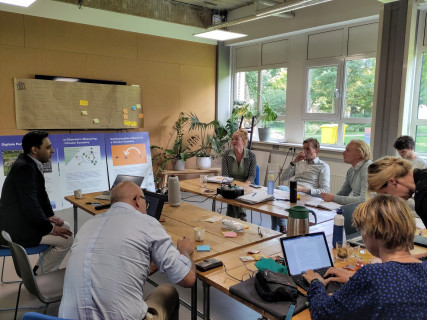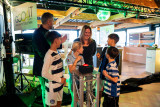Thursday, the 30th of August, we had the first follow-up session about Local Energy Systems (LES) since the Transition day session in June. Over the summer Omar Shafqat (HvA, ATELIER), dr. Renée Heller (HvA), and Lennart Zwols (municipality of Amsterdam), have worked on finding a solution to the barriers to scaling up LES. They focused on the barrier of sharing information and learnings of LES projects. In this session, Omar presented a framework that could help overcome this barrier.
A barrier to scaling up LES: Lack of knowledge
In the previous session, we discussed how the difficulty with starting a new LES project is often that the information on how to do this is not readily available. Many pilots have been done, or are still ongoing, and there are definitely reports on the learnings of these pilots. Unfortunately, these learnings are not always available to everyone, and if they are, quite difficult to find and aggregate.
Lennart therefore proposed to make a framework in which we can gather all the information on LES pilots and projects, so we have a central place for the collecting and sharing of information. Omar and Renée have created this framework, which Omar presented in this session. The framework has three objectives:
1. Collecting the learnings of the pilots in one place.
2. Defining the gaps in our knowledge.
3. Creating a starting point for people who want to create their own LES.
Definition of a Local Energy System
To properly create a framework in which various information of relevant LES projects can be collected, it was necessary to have a good definition of a LES. Omar presented the definition as follows:
A local energy system is an interactive, non-linear system that must contain:
- Local generation
- Controllable demand
- Storage
- Energy Management Systems
- Energy communities
Hans Roeland Polman (AMS) commented that he was missing the infrastructure in this definition. Omar clarified that the lines between these five entities symbolize the infrastructure and that it is indeed an important component of LESs.
When we speak of LES it is always a balancing act. Different stakeholders have different objectives for implementing a LES, maximizing renewables, minimizing costs, flexibility/congestion, grid dependence, etc. This implies that the aspects of a LES are of differing importance to stakeholders, which is important to take into account with information gathering and sharing.
The first version of the framework for collecting information
After discussing the definition of LES, we dived into the framework. The goal of this framework is to have one format in which we collect information and learnings from all the LES pilots and projects (starting with the ones in our own network). This will allow us to speak a common language, easily compare projects, identify stakeholders and their interests, see where the knowledge gaps are, and more easily find specific information about LES.
Note: This framework is not the interface for the end-user. The framework should be used to catalogue information and learnings so that we have the information on all the different projects in the same format. We can then use this to build a user interface that end-users can interact with. How to best do this is still a topic of discussion.
The framework is presented below. On the x-axis, you can see the time scale. On the left you have the long-term (planning) phase, and on the right the short-term (management) phase.
On the left side, you can see the four areas in which the framework is divided:
- Policy
- Energy markets
- Energy systems
- Community/user aspects
The colour-coded third dimensions show which blocks relate to certain topics of interest, and should have information added on this topic. The topics of interest that have been added now are:
- Congestion
- Energy balance
It might be interesting to add others as well.
It was suggested by the group that electricity/heating might also be an interesting topic to add. Hans (AMS) also suggested that it would be interesting to add information about local infrastructure, such as a local heat network.
Discussion and questions
After the presentation of the framework a discussion followed. Many questions were raised which require further examination. A few of the key questions were:
- What should the scope be of this framework? Are we just looking at our own region, or do we want it to be used on a much larger scale?
- How do we connect to the other organizations and projects to this framework, and refrain from doing double work?
- Who is the owner of this framework and will keep it up to date?
- To make this framework usable for project managers, it should have a clear template that can be filled in. Who is going to make this, and how do we ensure that project managers of LES projects fill this in?
Next steps and call to action:
There are still many questions that need to be answered, and we will continue the research and learn by doing. We will start with the ATELIER and the LIFE project, to see if we can put them into this framework. This will be done by Omar (HvA, ATELIER), and Hans (AMS, LIFE). They will also create the first version of a template in which the information can be collected so that project managers can fill out this information. This will then be tested with the project managers of the LIFE project to see if the template and framework are indeed workable.
This will give a good starting point to see if the framework is suitable for the collection of information and learnings of LES projects. However, it will be far from complete. The ATELIER and LIFE projects don’t contain all the topics to properly test the framework and create templates for everything. We therefore need more partners with LES projects that can help test and develop this framework.
So if you are working on a Local Energy System project, and you would like to help further develop the framework, by giving feedback on the framework itself or using your project to validate the effectiveness of the framework, please let us know.





